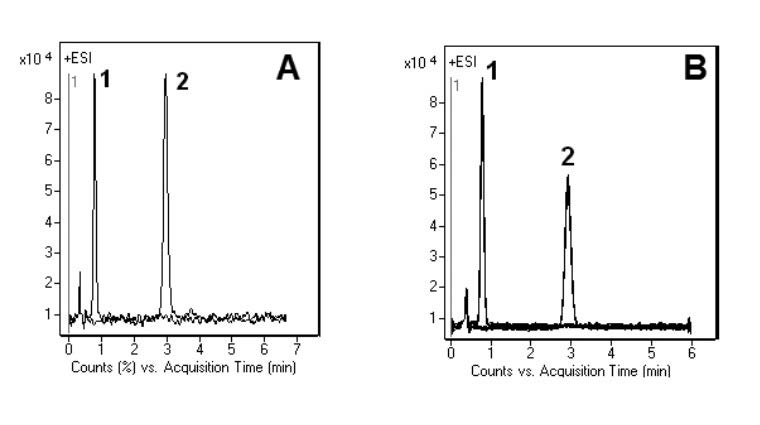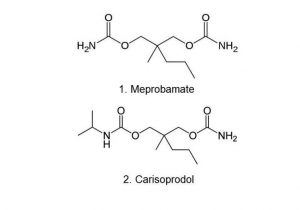Analysis of Closely Related Compounds
It has been reported that for the quantitation of Meprobamate and Carisoprodol, (in biological samples plasma, urine, hair etc) by LCMS, excessive analysis time and complex sample treatment (derivatization, solid or liquid phase extraction) may be required.
The Method in this AppNote shows a rapid way to quantitate both drugs in these samples with a simple one-step protein precipitation with Acetonitrile. The [13C – 2H3] – Meprobamate is recommended to be used as internal standard. When a lower detection limit is required for the analysis, the use of LC-MS/MS is recommended.

 Peaks:
Peaks:
1. Meprobamate
2. Carisoprodol
Method Conditions
Column: Cogent Bidentate C18™, 4µm, 100Å
Catalog No.: 40018-05P-2
Dimensions: 2.1 x 50mm
Mobile Phase:
—A: DI Water / 0.1% Formic Acid
—B: Acetonitrile / 0.1% Formic Acid
Gradient:
| Time (minutes) | %B |
| 0 | 40 |
| 5 | 100 |
| 6 | 40 |
Flow rate: 0.4mL / minute
Detection: ESI — POS – Agilent 6210 MSD TOF Mass Spectrometer
Injection vol.: 1μL
Sample Preparation:
—A: 300ng / mL prepared in methanol
—B: Urine extract, actual samples
t0: 0.4 minutes
Note: Meprobamate is a carbamate used as a sedative drug since the 50’s. It is also the main active metabolite of Carisoprodol, a skeletal muscle relaxant. Meprobamate is still widely prescribed, however it can be toxic which under some circumstances can lead to death. It is very often involved in accidental or suicidal overdoses. For all these reasons identification and quantification of both drugs is very important in toxicology. Carisoprodol is manufactured and marketed in the United States under the brand name SOMA not to be confused with the fictional drug mentioned in Brave New World by Aldous Huxley.
Attachment
No 124 Carisoprodol & Meprobamate Analysis by LCMS pdf 0.2 Mb Download File


